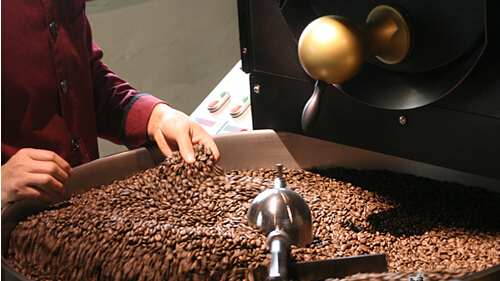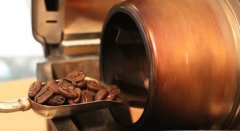Common sense about coffee roasting Coffee roasting Coffee Raw beans need to know Coffee Baking precautions
The most important step that affects the flavor of coffee is the method of baking.
There are many factors that affect baking, such as climate, humidity, hardness and water content of raw beans. Because of the many variables, the experience of baking is the most important key.
Before roasting, raw coffee beans have a fishy smell, and after baking, they will emit a strong aroma. The depth of roasting degree (roasting degree) of coffee beans will also affect coffee flavor and caffeine content. The lighter the roast, the stronger the acidity and the higher the caffeine content. The deeper the baking, the lighter the sour taste, the more obvious the sweet and bitter taste, and the lower the caffeine content.
Baking process:
When raw beans are baked at more than 200 degrees Celsius, the moisture begins to evaporate, the volume expands and the weight decreases. The deeper the baking, the more weight loss.
Another phenomenon is that during roasting, coffee beans release carbon dioxide, and the roasted cooked beans will continue to exhaust within 30 days, which helps coffee beans keep fresh. This is because when releasing carbon dioxide, oxygen molecules are not easy to invade and destroy the flavor of coffee, so coffee beans will not oxidize. If the coffee beans are oxidized, the flavor will quickly deteriorate, so the coffee brewed with fresh coffee beans has a particularly good flavor.

Baking tips:
Secret 1: to achieve the highest caramelization-caramelization is an important factor affecting the flavor of coffee, as raw beans absorb a lot of heat when roasting, then there is the first 1st cracking, at this time, the sugar begins to be converted into carbon dioxide, water continues to evaporate, the aroma of coffee will gradually come out and form coffee oil. This pyrolysis reaction can last until the second explosion (2nd cracking), but when the second explosion is completed, the temperature of the bean should be lowered immediately and as soon as possible, so that the highest caramelization can be obtained.
Tip 2: minimum carbonization-some ingredients will also be carbonized during the baking process, forming a bad bitter substance, so when you finish the second explosion, stop heating and minimize carbonization at the same time.
Tip 3: pay attention to the change in sound-coffee beans make two bursts during baking, and the first burst is low, indicating that the starch begins to turn into caramel and the water evaporates with carbon dioxide. The second burst sound is more violent and sharp, this is the sound of coffee bean cell fiber fracture, at this time should immediately stop heating, and as soon as possible with cold air to lower the temperature of the bean. The time of the first explosion and the second explosion can be very different, so baking different beans, it is necessary to find out the most suitable baking conditions for this bean.
Tip 4: pay attention to the changes in color and taste-the color of coffee beans will change from green to light brown as it continues to heat up, and then a small amount of oil will show a bright dark brown. At this point, you can no longer bake, otherwise the coffee oil on the surface of the beans will dry and give off a lot of smoke and scorched smell.
To sum up, coffee roasting is a science. The age, density, hardness and moisture content of raw beans will affect the quality of roasted coffee. Even the relative humidity and temperature on the day of roasting can not be ignored.
Just roasted coffee beans, it is best to put for 2-5 days, let a large amount of carbon dioxide out of the coffee beans after drinking will be more smooth, Hong Kong coffee will choose an one-way breathable valve aluminum foil bag to preserve coffee beans, can prevent the air from entering and causing oxidation, but also can let carbon dioxide out, to ensure that coffee beans remain fresh in the best condition.
Important Notice :
前街咖啡 FrontStreet Coffee has moved to new addredd:
FrontStreet Coffee Address: 315,Donghua East Road,GuangZhou
Tel:020 38364473
- Prev

The roasting degree determines the coffee taste, the flavor reflects the roasting degree and the characteristic roasting degree.
Baking degree and characteristics from the baking degree, the deeper the baking degree, the stronger the bitter taste; the shallower the baking degree, the stronger the sour taste. The choice of baking degree depends on the characteristics of the coffee bean itself. for coffee beans with strong bitterness and light sour taste, they generally choose a moderate and shallow roasting degree. 1. Shallow baking (Light) is the lightest fried culture, no fragrance and concentration.
- Next

Ember smart mug: keep the coffee at the best temperature for a longer time
Brewed coffee has a small bite that can bring it down to the desired temperature, but sometimes it gets cold quickly, especially when something else distracts you in the morning. California-based Ember Technologies has developed a coffee cup that claims to keep your drink at the right temperature for a long time, and users can set the temperature through the appropriate smartphone app or the bottom of the rotating cup.
Related
- What is the meaning of lactic acid fermentation with coffee bean treatment?
- How to judge the state of foam by sound?
- How does the latte pull out the unicorn pattern? Come to get for a little trick to improve the flower pull!
- Will flower pulling affect the taste of the latte?
- Do you know the history of coffee?
- The difference between honey treatment and sun washing what is raisin honey treatment?
- What kind of milk can a novice use to make coffee foam to keep the foam longer? The correct method and skills of milking tutorial sharing
- Why do washed coffee beans taste sour? Flavor characteristics of washed Coffee
- Introduction to the skill of how to practice the size and height of water injection around the circle of hand-brewed coffee
- How do beginners practice coffee flower drawing from scratch?

